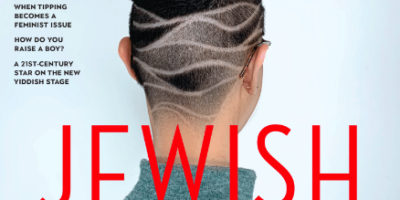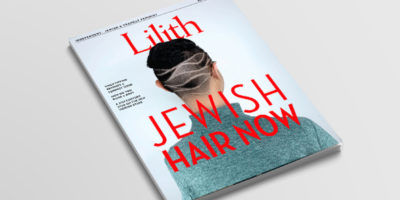
Hair as a Jewish Art Form: A Parasha Haircut Project
It was late October. I had been going to a new barber recently. I had seen Billy’s (@Odabu) incredible line work on Instagram and was ready to start doing bolder things with my hair. On this day, I walked in and said: “I’ve been thinking a lot about water and waves lately, waves that roll and curl over themselves.” With no further explanation, Billy pulled out his razors and started prepping the canvas of my head. An hour later Billy held a small mirror to my face and I saw the reflection of the back of my head in the backlit mirror. I was awestruck at the mural that had been carved into my head. Waiting for the trolley home, I continued to reflect on water and noticed where I was in Jewish time. I had just danced with the Torah in the streets at Simchat Torah and studied parasha Breishit, the very first section of the weekly Torah portion. I reached my hands to the back of my head and traced the shapes in my head. “בראשית ברא אלוהים את השמים ואת הארץ.” (In the beginning, G-d created the heavens and the earth.) “Breishit,” I said to myself.
The story of Breishit was now carved into the back of my head. In a period where antisemitism is on the rise and there is live conversation around walking through this world Jewishly, I would proclaim my Judaism publicly by donning a parasha a month in my hair, and thus, #ParashaHaircuts was born.

This project is like a drash (an interpretation of the text) upon a drash upon a drash, an interpretation of the biblical text that is transformed. First, I have to interpret the parasha (weekly Torah portion) and create my vision for how I would depict it. Then, I have to translate that image into words that could describe something that can be shaved into my hair for a barber with mastery of the razor and minimal knowledge of the Torah. At that point, I listen to the buzz of the razor and feel the aloe trace the lines on my head as I wait with curiosity and anticipation to be handed the mirror. Each time, I’m impressed at the artistry I see, but what has been carved into demands me to create yet another drash. I am often forced to wrestle with my interpretation of the parasha with the moment illustrated in my hair. It’s a process that seems to so perfectly reflect our tradition – where our stories have been told and retold over millennia.
In late November I walked into Billy’s studio for parasha Chayei Sarah. I was still spending a lot of time meditating on the theme of water. Parasha Chayei Sarah is filled with tropes of water, from Abraham mourning Sarah to Rebecca drawing water from the well. I told Billy that I had a vision of tears flowing down the back of my head. When he turned the mirror back at me, I saw big and heavy droplets. On the trolley home in Philadelphia, I looked through my Facebook memories. Three years earlier to the day, I had left for Standing Rock. I would go to be a water protector, defending indigenous land and living waters. My haircuts were truly becoming drashot at this point, drawing on the Torah text as well as my own life experience and Billy’s creativity, interpretation, and skills all illustrated on the back and sides of my head.

On Instagram, a rabbinical colleague commented: “[My chevurta] and I were just talking about all the times tears show up in Midrash! The angels cried into yizchak’s eyes as he was bound on the altar, which causes his ‘eyes to dim’. And the multiple midrashim about Sarah- when she find out what *almost* happened to her son she cried and wailed, and her soul leapt out of her body.” I was so struck by this drash, reflecting on the grief and heaviness in the droplets on my head. The project came alive in my colleagues’ interaction with me and the continuing drashot they offered. It made me wonder about the stories that strangers tell when they pass me in the streets, that fellow Jews will tell when they sit behind me in shul. It is exciting for me to be let into the minds of those who engage in my social media presence and share their drashot with me. #ParashaHaircuts is truly an interactive project in so many ways.
I had no idea how to describe Joseph’s dream to my barber. As a rabbinical student I remind myself that not everyone is interested in religion and surely there aren’t many who want to be offered a sermon prompting. When I’ve described this project to Billy, he’s been supportive and excited about the creativity we are both able to bring to the project, though I’ve never felt an invitation or his interest to delve deeply into the material content of the parshiot. We are creative partners and collaborators in an artistic project. So this week, I again translated my interpretation of the parasha into words that may be easily translatable into something visual I said to him: “This week I am inspired by Van Gogh’s Starry Night and dreaming and I think I want there to be a moon shape.” Again Billy worked his magic. He turned the mirror back at me, and I took a few glances. Whatever doodles I had scribbled in the margins of my class notes did not remotely match what had just been carved into the back of my head. I smiled at Billy with genuine awe at his artistry while feeling a pit in my stomach. I was going to have to make another drash.
After I shared my next haircut for parasha Vayeshev on Facebook, another rabbinic colleague commented: “Swirls of light into dark and dark into light. Hanukkah, havdalah and the joy of changes all rolled into one.” She brought more timely relevance to a haircut that I intended, somehow, to represent a dream. She wove together for me the way that the parasha interacted with Jewish time, coinciding with Hanukkah.This is the beauty of this project, the opportunity to engage and wrestle and reconcile with the texts of my tradition over and over. I am grateful for this embodied way to learn my tradition and this new way of carrying it with me. I witness the transformation of my drashot as well as noticing the way the stories change on my head as my hair grows.

May Ye is a Chinese-American rabbinical student at the Reconstructionist Rabbinical College. You can follow her haircut journey @ParashaHaircuts and follow her barber @odabu_ on Instagram.



